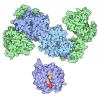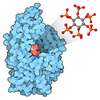+ Open data
Open data
- Basic information
Basic information
| Entry | Database: PDB / ID: 8x3s | ||||||
|---|---|---|---|---|---|---|---|
| Title | Crystal structure of human WDR5 in complex with PTEN | ||||||
 Components Components |
| ||||||
 Keywords Keywords | CELL CYCLE / Complex / Cell Proliferation / Cancer | ||||||
| Function / homology |  Function and homology information Function and homology informationPTEN Loss of Function in Cancer / inositol-1,3,4,5,6-pentakisphosphate 3-phosphatase activity / negative regulation of keratinocyte migration / phosphatidylinositol-3,4-bisphosphate 3-phosphatase activity / negative regulation of synaptic vesicle clustering / phosphatidylinositol-3,4,5-trisphosphate 3-phosphatase / negative regulation of peptidyl-serine phosphorylation / phosphatidylinositol phosphate phosphatase activity / rhythmic synaptic transmission / inositol-1,3,4,5-tetrakisphosphate 3-phosphatase activity ...PTEN Loss of Function in Cancer / inositol-1,3,4,5,6-pentakisphosphate 3-phosphatase activity / negative regulation of keratinocyte migration / phosphatidylinositol-3,4-bisphosphate 3-phosphatase activity / negative regulation of synaptic vesicle clustering / phosphatidylinositol-3,4,5-trisphosphate 3-phosphatase / negative regulation of peptidyl-serine phosphorylation / phosphatidylinositol phosphate phosphatase activity / rhythmic synaptic transmission / inositol-1,3,4,5-tetrakisphosphate 3-phosphatase activity / central nervous system myelin maintenance / negative regulation of wound healing, spreading of epidermal cells / phosphatidylinositol-3-phosphate phosphatase activity / central nervous system neuron axonogenesis / postsynaptic density assembly / neuron-neuron synaptic transmission / Negative regulation of the PI3K/AKT network / synapse maturation / negative regulation of cell cycle G1/S phase transition / myelin sheath adaxonal region / Regulation of PTEN mRNA translation / cellular response to electrical stimulus / presynaptic membrane assembly / regulation of phosphatidylinositol 3-kinase/protein kinase B signal transduction / negative regulation of axonogenesis / phosphatidylinositol-3,4,5-trisphosphate 3-phosphatase activity / Transcriptional Regulation by MECP2 / negative regulation of organ growth / forebrain morphogenesis / negative regulation of focal adhesion assembly / phosphatidylinositol dephosphorylation / negative regulation of excitatory postsynaptic potential / Hydrolases; Acting on ester bonds; Phosphoric-monoester hydrolases / anaphase-promoting complex binding / histone H3Q5ser reader activity / dentate gyrus development / histone H3K4me1 reader activity / Schmidt-Lanterman incisure / Epigenetic regulation of gene expression by MLL3 and MLL4 complexes / phosphatidylinositol biosynthetic process / dendritic spine morphogenesis / MLL3/4 complex / maternal behavior / ubiquitin ligase activator activity / Set1C/COMPASS complex / MLL1/2 complex / ATAC complex / negative regulation of cell size / NSL complex / positive regulation of ubiquitin-dependent protein catabolic process / histone H3K4 methyltransferase activity / spindle assembly involved in female meiosis / Cardiogenesis / negative regulation of epithelial to mesenchymal transition / molecular function inhibitor activity / protein-serine/threonine phosphatase / negative regulation of G1/S transition of mitotic cell cycle / Formation of WDR5-containing histone-modifying complexes / ubiquitin-specific protease binding / regulation of neuron projection development / Synthesis of IP3 and IP4 in the cytosol / locomotor rhythm / Synthesis of PIPs at the plasma membrane / adult behavior / protein serine/threonine phosphatase activity / histone methyltransferase complex / regulation of cell division / positive regulation of intracellular signal transduction / phosphoprotein phosphatase activity / negative regulation of vascular associated smooth muscle cell proliferation / MLL1 complex / negative regulation of cellular senescence / regulation of embryonic development / histone acetyltransferase complex / social behavior / positive regulation of excitatory postsynaptic potential / negative regulation of osteoblast differentiation / prepulse inhibition / multicellular organismal response to stress / protein dephosphorylation / synapse assembly / protein-tyrosine-phosphatase / positive regulation of gluconeogenesis / negative regulation of phosphatidylinositol 3-kinase/protein kinase B signal transduction / transcription initiation-coupled chromatin remodeling / protein tyrosine phosphatase activity / Regulation of PTEN localization / negative regulation of cell migration / central nervous system development / gluconeogenesis / skeletal system development / TP53 Regulates Metabolic Genes / cell projection / PDZ domain binding / locomotory behavior / phosphatidylinositol 3-kinase/protein kinase B signal transduction / cell motility / RUNX1 regulates genes involved in megakaryocyte differentiation and platelet function / PML body / beta-catenin binding Similarity search - Function | ||||||
| Biological species |  Homo sapiens (human) Homo sapiens (human) | ||||||
| Method |  X-RAY DIFFRACTION / X-RAY DIFFRACTION /  SYNCHROTRON / SYNCHROTRON /  MOLECULAR REPLACEMENT / Resolution: 1.87 Å MOLECULAR REPLACEMENT / Resolution: 1.87 Å | ||||||
 Authors Authors | Liu, Y. / Huang, X. / Shang, X. | ||||||
| Funding support |  China, 1items China, 1items
| ||||||
 Citation Citation |  Journal: Cell Death Dis / Year: 2024 Journal: Cell Death Dis / Year: 2024Title: The NTE domain of PTEN alpha / beta promotes cancer progression by interacting with WDR5 via its SSSRRSS motif. Authors: Huang, X. / Zhang, C. / Shang, X. / Chen, Y. / Xiao, Q. / Wei, Z. / Wang, G. / Zhen, X. / Xu, G. / Min, J. / Shen, S. / Liu, Y. | ||||||
| History |
|
- Structure visualization
Structure visualization
| Structure viewer | Molecule:  Molmil Molmil Jmol/JSmol Jmol/JSmol |
|---|
- Downloads & links
Downloads & links
- Download
Download
| PDBx/mmCIF format |  8x3s.cif.gz 8x3s.cif.gz | 76.7 KB | Display |  PDBx/mmCIF format PDBx/mmCIF format |
|---|---|---|---|---|
| PDB format |  pdb8x3s.ent.gz pdb8x3s.ent.gz | 55 KB | Display |  PDB format PDB format |
| PDBx/mmJSON format |  8x3s.json.gz 8x3s.json.gz | Tree view |  PDBx/mmJSON format PDBx/mmJSON format | |
| Others |  Other downloads Other downloads |
-Validation report
| Arichive directory |  https://data.pdbj.org/pub/pdb/validation_reports/x3/8x3s https://data.pdbj.org/pub/pdb/validation_reports/x3/8x3s ftp://data.pdbj.org/pub/pdb/validation_reports/x3/8x3s ftp://data.pdbj.org/pub/pdb/validation_reports/x3/8x3s | HTTPS FTP |
|---|
-Related structure data
| Related structure data |  8x3rC C: citing same article ( |
|---|---|
| Similar structure data | Similarity search - Function & homology  F&H Search F&H Search |
- Links
Links
- Assembly
Assembly
| Deposited unit | 
| ||||||||
|---|---|---|---|---|---|---|---|---|---|
| 1 |
| ||||||||
| Unit cell |
|
- Components
Components
| #1: Protein | Mass: 34478.070 Da / Num. of mol.: 1 Source method: isolated from a genetically manipulated source Source: (gene. exp.)  Homo sapiens (human) / Gene: WDR5 / Production host: Homo sapiens (human) / Gene: WDR5 / Production host:  |
|---|---|
| #2: Protein/peptide | Mass: 3466.780 Da / Num. of mol.: 1 Source method: isolated from a genetically manipulated source Source: (gene. exp.)  Homo sapiens (human) / Gene: PTEN, MMAC1, TEP1 / Production host: Homo sapiens (human) / Gene: PTEN, MMAC1, TEP1 / Production host:  References: UniProt: P60484, protein-serine/threonine phosphatase, protein-tyrosine-phosphatase, phosphatidylinositol-3,4,5-trisphosphate 3-phosphatase |
| #3: Water | ChemComp-HOH / |
-Experimental details
-Experiment
| Experiment | Method:  X-RAY DIFFRACTION / Number of used crystals: 1 X-RAY DIFFRACTION / Number of used crystals: 1 |
|---|
- Sample preparation
Sample preparation
| Crystal | Density Matthews: 1.81 Å3/Da / Density % sol: 32.11 % Description: The entry contains friedel pairs in I_plus/minus columns |
|---|---|
| Crystal grow | Temperature: 289 K / Method: vapor diffusion, sitting drop Details: 0.2 M lithium sulfate monohydrate, 0.1 M HEPES at pH 7.5, 25% w/v polyethylene glycol 3350 |
-Data collection
| Diffraction | Mean temperature: 100 K / Serial crystal experiment: N |
|---|---|
| Diffraction source | Source:  SYNCHROTRON / Site: SYNCHROTRON / Site:  SSRF SSRF  / Beamline: BL10U2 / Wavelength: 0.97918 Å / Beamline: BL10U2 / Wavelength: 0.97918 Å |
| Detector | Type: DECTRIS EIGER X 16M / Detector: PIXEL / Date: Sep 4, 2022 |
| Radiation | Protocol: SINGLE WAVELENGTH / Monochromatic (M) / Laue (L): M / Scattering type: x-ray |
| Radiation wavelength | Wavelength: 0.97918 Å / Relative weight: 1 |
| Reflection | Resolution: 1.87→29.19 Å / Num. obs: 22670 / % possible obs: 97 % / Redundancy: 1.8 % / CC1/2: 0.994 / Net I/σ(I): 10.5 |
| Reflection shell | Resolution: 1.87→1.91 Å / Num. unique obs: 1831 / CC1/2: 0.627 |
- Processing
Processing
| Software |
| ||||||||||||||||
|---|---|---|---|---|---|---|---|---|---|---|---|---|---|---|---|---|---|
| Refinement | Method to determine structure:  MOLECULAR REPLACEMENT / Resolution: 1.87→29.19 Å / Cross valid method: FREE R-VALUE MOLECULAR REPLACEMENT / Resolution: 1.87→29.19 Å / Cross valid method: FREE R-VALUEDetails: The entry contains friedel pairs in I_plus/minus columns
| ||||||||||||||||
| Refinement step | Cycle: LAST / Resolution: 1.87→29.19 Å
|
 Movie
Movie Controller
Controller



 PDBj
PDBj













